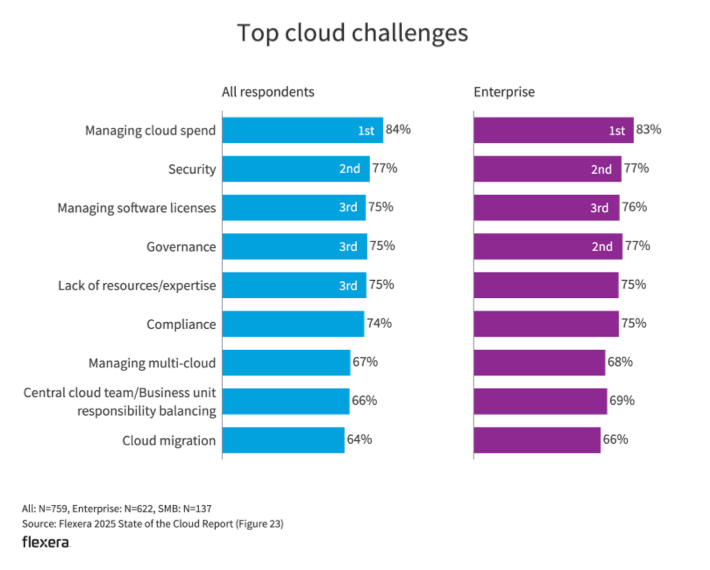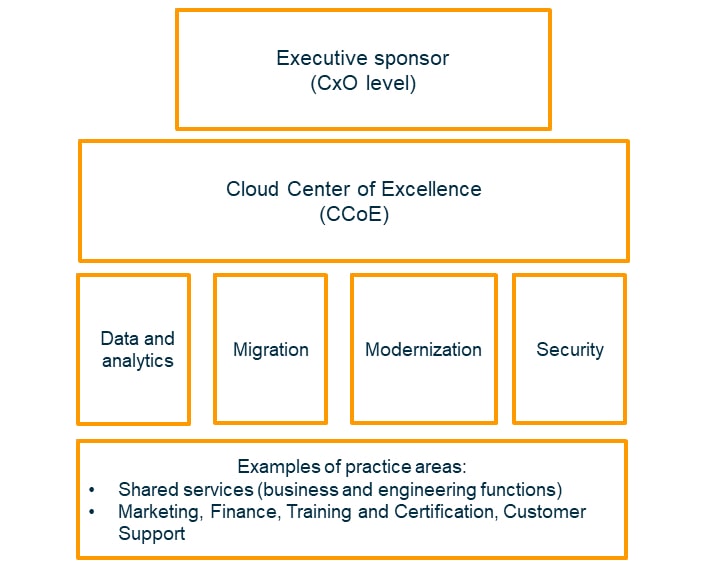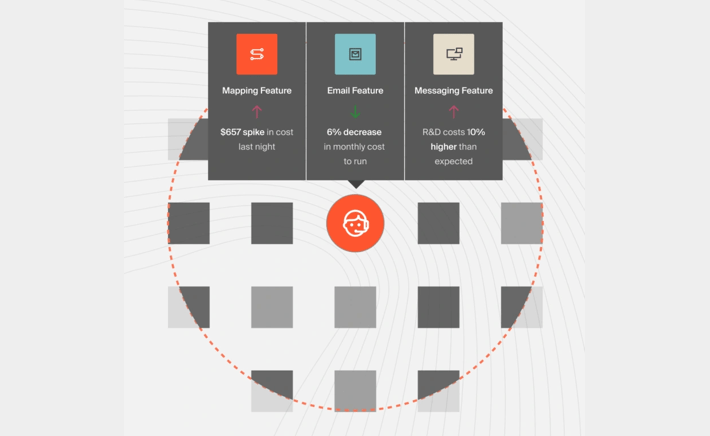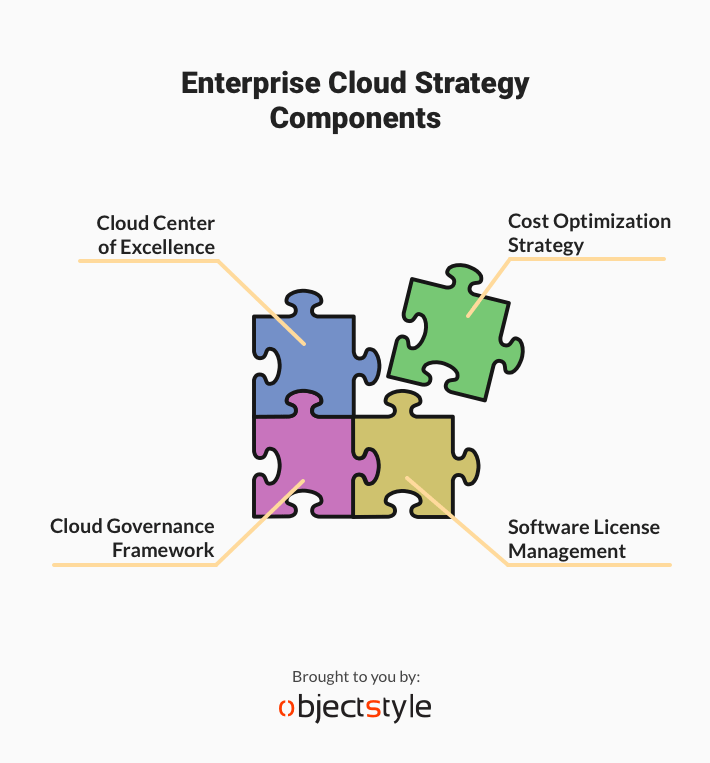
With the following article, we tap into ObjectStyle’s 15+ years of experience with cloud systems, enterprise infrastructures, and industry-leading DevSecOps practices.
According to Flexera 2025 State of the Cloud Report, managing cloud spend is top of mind for most organizations, with 84% of respondents calling it their #1 cloud challenge. Adding to the surging costs is GenAI, which is now being used by at least 50% of survey respondents. Therefore, having a solid and all-around cloud strategy is no longer optional—it’s of absolute necessity.
What Is an Enterprise Cloud Strategy?
Enterprise cloud strategy is a vision for tackling top cloud challenges facing enterprises today (managing cloud spend, security, governance, software license management, compliance, lack of resources/expertise, and cloud team/business team responsibility balancing) as well as using enterprise cloud solutions to achieve business objectives (cost savings, scalability, performance optimization, compliance, or innovation).

Creating a Winning Enterprise Cloud Strategy
The choice of strategy depends on which cloud challenges or business goals are a priority for a particular company. At the same time, many enterprises share similar pains and opportunities. Therefore, let us look at an abstract all-in-one strategy that can be implemented fully or partially according to one’s specific situation.
🧩 1. Establish a CCoE (Cloud Center of Excellence)
A Cloud Center of Excellence (CCoE) is a group responsible for defining and implementing enterprise cloud strategy within an organization. According to the aforementioned Flexera 2025 State of the Cloud Report, 74% of enterprises already have a CCoE, and 14% are planning to form one in the next twelve months. The odds are your company already has a central cloud team. If not, it’s high time to take a unified approach to the cloud and assemble a CCoE.
A CCoE is a cross-functional body that brings together employees from engineering, finance, security, and governance. The team’s composition may vary from company to company. It also depends on the level of cloud maturity your organization has.
The CCoE’s key responsibilities are:
- Creating and implementing enterprise cloud strategy
- Developing and enforcing cloud governance policies
- Tracking and optimizing cloud costs
At the same time, the CCoE’s overarching goal is establishing and promoting a culture that drives innovation and ongoing improvement in your organization’s cloud usage.
Important: it is essential that the CCoE gets sufficient sponsorship from a C-level executive (e.g., CTO or CIO) who has the authority to make decisions and drive cloud initiatives.
A guide by AWS, Building a Cloud Center of Excellence within your organization, offers a sixteen-step process for establishing a CCoE in your company. We recommend consulting this guide for further details on how to create and run your central cloud team. The guide also proposes a hypothetical CCoE structure:

🧩 2. Build a Solid Cloud Governance Framework
77% of enterprise organizations say they struggle with cloud governance. Having a robust framework for it helps improve a company’s cloud governance posture.
Cloud governance posture refers to the current state of an organization’s policies, processes, and controls for managing and securing its cloud resources. It reflects how well an organization governs its use of cloud services to ensure compliance, security, cost optimization, and operational efficiency.
2.1. Assessing Your Cloud Governance Posture
Organizations often use cloud governance frameworks and tools (for example, AWS Config, Azure Policy, Google Cloud Organization Policy) to evaluate their posture by answering questions like:
- Are we enforcing least-privilege access?
- Do we have visibility into all cloud assets?
- Are we compliant with applicable internal and external standards?
- Can we track and control cost usage?
Once you diagnose the current state of cloud governance in your organization, you can then create a cloud governance framework, which is a blueprint for secure, efficient, and compliant use of cloud resources.
2.2. Creating a Cloud Governance Framework
A cloud governance framework defines policies, processes, and controls aimed at optimizing cloud resource usage, while ensuring security, compliance, and cost efficiency.
Essential components of a cloud governance framework include:
Cloud Cost Management. The goal is to prevent cost overruns and ensure efficient resource usage—please find detailed information on that in Section 3 of our article. In a nutshell, cloud cost management consists of budgeting and cost allocation by team/project, cost monitoring and forecasting, rightsizing and eliminating unused resources, utilizing various resource tracking strategies, among other practices.
Identity and Access Management. Having a centralized IAM (Identity and Access Management) system enables a more streamlined access and authentication processes. As a rule, IAM includes tactics like role-based and least privilege access control, identity federation (single sign-on, multi-factor authentication), as well as logging and monitoring for suspicious activity.
Ensuring Data Security. Comprehensive data security goes beyond ID and access management. Apart from controlling who has access to what, it’s important to classify and understand the composition of your cloud data. A common approach is to encrypt sensitive data, as well as data at rest, in transit, and in use. You should also perform regular security audits to maintain data integrity and prevent breaches.
Compliance and Risk Management. The goal is to ensure adherence to legal, regulatory, and internal policies. Key practices include regulatory framework mapping (HIPAA, SOC 2, etc.), policy-as-code enforcement (via tools like Open Policy Agent or Azure Policy), and third-party vendor risk assessments. Many enterprises, especially those in heavily-regulated industries, use specialized GRC (Governance, Risk, and Compliance) platforms like LogicGate, OneTrust, or Riskonnect for unified/automated risk and compliance management.
Resource and Configuration Management. It lies in standardizing and automating your cloud infrastructure to ensure consistency and prevent drift. It’s important to have sufficient oversight over how cloud resources are requested, used, and decommissioned to avoid resource sprawl. Resource usage can be optimized through automated provisioning (through DevOps practices like IaC), smart cost management, and drift detection and remediation.
Last but not least, if you have a CCoE (Cloud Center of Excellence) in place, this will help you align your cloud governance framework with business objectives.
🧩 3. Use Advanced Cloud Cost Saving Tactics
The reason so many enterprises struggle with optimizing cloud spend is that cloud costs are notoriously tricky to manage: they are dynamic and increase/descrease depending on usage.
Unlike well-known cloud cost optimization tactics such as rightsizing instances or retiring unused resources, strategic measures include more high-level, comprehensive activities like automation, choosing the right tooling and looking for the root cause of cloud waste.
Below we have gathered strategic recommendations for optimizing cloud costs.
3.1. Embrace Unit Economics
According to Flexera 2025 State of the Cloud Report, only 43% of enterprises use unit economics. What is unit economics in the cloud context? It is tracking cloud expenses at a granular level. Instead of looking at average costs, you should be monitoring cost per unit, where a unit is any entity relevant to your business. For example, you can track cost per application, cost per feature, cost per customer, etc.

Unit economics allows a company to tie cloud investments to specific business outcomes. For example, you can see which features or unit segments are the biggest revenue drivers and see how that correlates with their cloud spend.
3.2. Invest in Cross-Cloud Management Tools
Every big enterprise cloud service provider offers a native cost management capability (Azure Cost Management, Google Cloud Billing, AWS Cost Explorer). While those instruments are great, the next step is to look at cross-cloud visibility solutions like Flexera One, CloudHealth by VMware or Cloudability by Apptio/IBM. As a rule, these multi-cloud management tools not only help reduce cloud spend, but can also optimize cloud data placement for better performance and compliance.
3.3. Foster FinOps-Aware Engineering Culture
The old way of slashing cloud costs meant optimizing current spend. The new way is preventing unnecessary cloud costs with smart engineering. Developers often lack awareness as to how their architectural decisions impact the financial bottom line. Modern organizations strive to increase engineers’ FinOps literacy.
Many even resort to gamification to get developers to care about FinOps. For example, GitLab came up with a contest where teams competed to achieve the highest cost savings. By the end of the contest, the company’s Kubernetes costs went down by 10%, which was a big success.
3.4. Measure AI ROI
A 2025 report by Flexera stated that GenAI adoption exploded this year, with a mind-blowing 72% of organizations using generative AI public cloud services either sparingly or extensively—a sharp uptick from the 47% reported last year. Since we are still going through the “inflated expectations” phase of the GenAI hype cycle, it’s important to measure hard-dollar return on investment for the AI initiatives the company is running. The chances are, your GenAI-powered products are eating up quite a big part of the cloud budget. If that’s the case, it’s essential to ensure real value generation from GenAI adoption.
🧩 4. Manage Software Licenses Wisely
The final piece of a solid cloud strategy is dedicating special attention to software license management.
According to many enterprise companies, software license management is their third-largest cloud challenge. Indeed, software costs can account for a big portion of cloud bills. In order to avoid overspending on SaaS licenses, use tactics like BYOL (Bring Your Own License) and PAYG (Pay As You Go), combined with classic subscription models.
4.1. BYOL (Bring Your Own License)
BYOL allows organizations to use existing software licenses (e.g., Windows Server, SQL Server, Oracle) in cloud environments like AWS, Azure, or GCP.
BYOL Tactics:
- License inventory mapping. Maintain an accurate inventory of licenses eligible for BYOL and track their entitlements and usage.
- Use on supported instances. Cloud providers offer specific instance types optimized for BYOL (for example, AWS EC2 “Dedicated Hosts” or “BYOL AMIs”).
- Compliance monitoring. Ensure license usage matches terms (core counts, geographic restrictions) to avoid audits and penalties.
4.2. PAYG (Pay-As-You-Go) Licensing
When using this model, you get charged based on actual usage, which is common in cloud marketplaces like AWS Marketplace and Azure Marketplace.
PAYG Tactics:
- Auto-terminate unused resources. Use automation to shut down idle workloads or software instances to avoid unnecessary charges.
- Analyze usage patterns. Identify tools where usage fluctuates and switch to PAYG for cost efficiency.
- Compare TCO. In some cases, PAYG is more expensive than reserved/subscription models, so it helps to run side-by-side comparisons.
4.3. Combining BYOL + PAYG + Subscription Models
The most efficient SaaS/cloud licensing strategy is to use a hybrid approach:
- Use BYOL for predictable, long-term workloads where you already own licenses.
- Use PAYG for burst workloads, dev/test, or pilot projects.
- Use Enterprise Licensing for standardized high-usage software across the organization.
Pro Tip: Many companies use licensing optimization tools (Flexera, Snow Software, CloudHealth, etc.) to detect BYOL opportunities, track PAYG costs and come up with optimal licensing strategies based on actual usage.
In Conclusion
An effective enterprise cloud strategy that saves money and ensures security must be deliberate, monitored, and constantly optimized. While specific strategy components may vary from company to company, we recommend covering the following four areas:
- Cloud Center of Excellence
- Cloud Governance Framework
- Cost Optimization Strategy
- Software License Management

Having these essential “puzzle pieces” covered, you will certainly create a winning enterprise cloud strategy for your organization.
Lead image credit: epicantus via Pixabay.
(Uber)-Useful Resources:
Building a Cloud Center of Excellence: A Guide by AWS
Enterprise Cloud Strategy: A Whitepaper by Microsoft Press
The Cloud Cost Playbook: A Guide by Cloudzero
Related Blogs

In the Cloud, Everyone Is Looking to Save
LEARN MORE